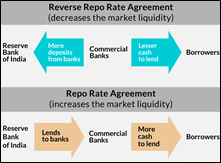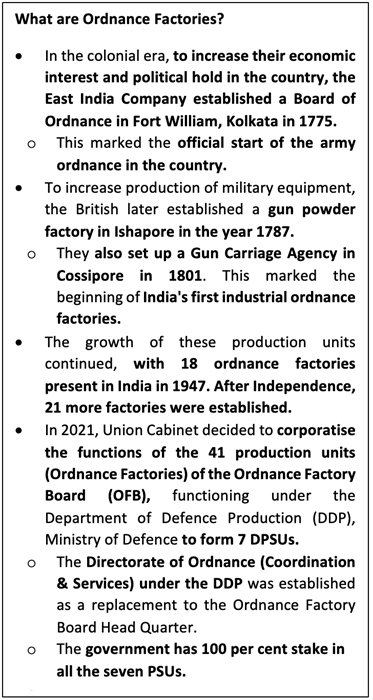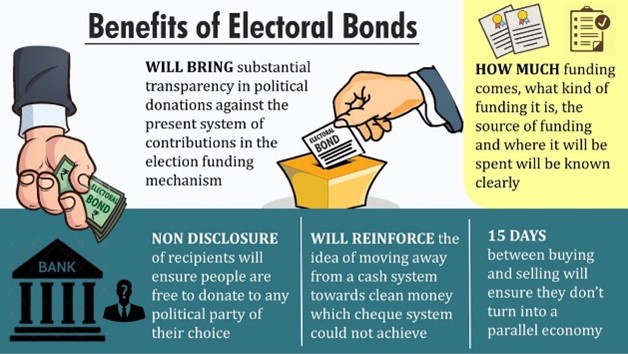Wednesday, 13th April 2022
Mid-day meal
In News
The government of Karnataka has proposed to provide eggs under the midday meal scheme from the next academic session for schoolchildren.
About the News
- If implemented, Karnataka is likely to become the 13th state to do so under the midday meal scheme which is among the largest initiatives in the world to enhance nutrition levels of school-going children through hot cooked meals.
- The proposal comes on the back of successive surveys pointing out high prevalence of malnutrition, anaemia and low immunity among children in many parts of the state, where the National Family Health Survey-V found 35% children under five stunted, and around 20% wasted.
What is Mid-day meal scheme?
- History of the scheme: The first initiative to provide meals to children had been taken by the erstwhile Madras Municipal Corporation around 1920. Post-independence, Tamil Nadu was again the pioneer to roll out a school feeding scheme in 1956. Kerala followed up to have a school lunch programme in 1984.
- Current format: The current version of the programme, renamed PM Poshan Shakti Nirman or PM Poshan in 2021, traces its roots to 1995. It was launched as a centrally sponsored scheme across 2,408 blocks for students up to Class 5 and later extended to class 8 in 2007.
- Scale of the scheme:
- Coverage: The scheme covers 11.80 crore children across Classes 1 to 8 (age group 6 to 14)20 lakh government and government-aided schools and those run by local bodies such as the municipal corporations in Delhi under the provisions of the National Food Security Act, 2013 (NFSA).
- Mandates of the scheme:
- Statutory obligation: It is not just a scheme, but a legal entitlement of all school-going children in primary and upper primary classes, through the National Food Security Act (NFSA), 2013, as well as the Supreme Court’s ruling in People’s Union of Civil Liberties vs Union of India and Others (2001).
- Role of states: Under the rules, the allocation of Rs 4.97 per child per day (primary classes) and Rs 7.45 (upper primary) are shared in 60:40 ratio with states and UTs with a legislature, and 90:10 with the North-eastern states, Jammu and Kashmir, Himachal Pradesh and Uttarakhand, while the Centre bears 100% of the costs in UTs without
- Additional items: If the states and UTs seeks to supplement the meals with additional items such as milk and eggs they need to contribute more. Components such as payments to cooks and workers are also split in the same ratio between the Centre and states.
- Cost of transportation and storage: Centre bears the entire cost of foodgrains and their transportation, and also handles the expenditure on management, monitoring and evaluation of the scheme.
- Components of the scheme:
- Nutritional components: Although the menu varies from one state or Union Territory to another but the authorities are needed to ensure that the nutritional component of the meal made up of rice, pulses, vegetables, oil and fat provide at least 450 calories and 12 gm protein to children in primary grades and 700 calories and 20 gm protein for upper primary children.
- Additional items: The variations are in the cases of additional items such as milk, eggs, chikki, or fruits that the states provide as supplementary nutrition, the expenses for which are borne by the state government.
What are the issues around the scheme?
- Variations in supplementary nutrition:
- Eggs: These are currently provided only by 13 states and three UTs that too with variations. For example, Tamil Nadu provides eggs on all school working days while Sikkim, once a month.
- Milk: States and UTs that provide milk include Gujarat, Karnataka, Kerala, Madhya Pradesh, Mizoram, Rajasthan, Uttarakhand, Ladakh and Puducherry.
- Other food items: West Bengal provides cheese and mushroom on a limited scale, while Andhra Pradesh and Maharashtra provide chikki. In Lakshadweep, chicken is provided as well.
- Issues around eggs:
- Cost: Even though states such as Arunachal Pradesh, find it costly.
- Politics: Dietary choices are an intensely contested area in India due to caste rigidities, religious conservatism and regional differences. As a result, despite scientific studies showing the benefits of giving children eggs, many states have been reluctant about adding eggs to the school lunch menu.
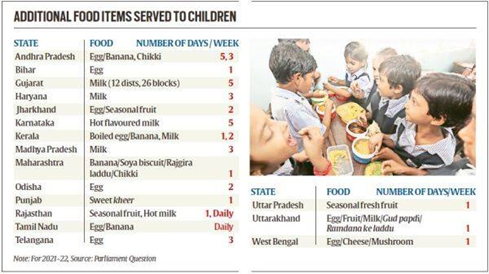
Source:
Rising stockpile of nuclear warheads
In News
Global nuclear watchdog has warned of the rising number of nuclear warheads in usable stockpiles
About the News
- Norwegian nuclear watchdog the Nuclear Weapons Ban Monitor has recently released a finding report on world's stockpile of usable nuclear weapons.
- It tracks the progress towards a world without nuclear weapons, highlights activities that hamper such progress, and analyses the key challenges to nuclear disarmament.
- It uses the Treaty on the Prohibition of Nuclear Weapons (TPNW) as the primary yardstick to track progress towards a world without nuclear weapons.
- It also tracks the status of all states in relation to all other relevant multilateral treaties and regimes dealing with nuclear weapons and other weapons of mass destruction is also tracked, including the Treaty on the Non-Proliferation of Nuclear Weapons (NPT), the Comprehensive Nuclear-Test-Ban Treaty (CTBT), the Biological Weapons Convention (BWC), and the Chemical Weapons Convention (CWC).
- The Nuclear Weapons Ban Monitor is researched and published by Norwegian People’s Aid with contributions from a range of external experts.
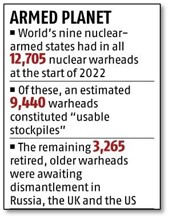
What are the major highlights of the findings?
- Increasing Nuclear Arms: According to report, the world’s nine nuclear-armed states had a combined arsenal of 12,705 nuclear warheads at the beginning of There is no evidence that any of the nuclear-armed states currently have the will to purposefully pursue nuclear disarmament.
- The findings were based on the study of the conduct in 2021 of total 153 states equating to almost 78% of the global total stockpiles.
- Usable stockpiles: An estimated 9,440 warheads – with a collective yield equivalent to approximately 138,000 Hiroshima-bombs – constituted “usable stockpiles”, available for use by the nuclear armed states on their missiles, aircraft, submarines and ships.
- Retired stockpile: An estimated 3,265 retired, older warheads were awaiting dismantlement in Russia, the United Kingdom, and the United States.
- Growth of stockpile: The total number of nuclear warheads in the world continued to decrease slightly in 2021, but only because the US and Russia dismantle a small number of their retired, older nuclear warheads every year. Since then, the number of nuclear warheads in global usable stockpiles has even started to increase again.
- Treaty on the Prohibition of nuclear weapons (TPNW): The watchdog has found that there was increasing engagement in 2021 with the TPNW, which entered into force in 2021 and which is seen as a vehicle for resistance to the permanence of nuclear weapons in world politics.
- Limited sphere of influence: The states not compatible with the TPNW are first and foremost the nine nuclear-armed states and the 32 so-called umbrella states (most of which are European states). All of the umbrella states acted as enabler in Nuclear Armament.
- These 32 states aid and abet nuclear-armed states’ retention of nuclear weapons in several ways, including by participating in nuclear strike exercises and nuclear planning; provision of logistical and technical support; endorsement of nuclear-weapons doctrines, policies and statements; and with development, production, and maintenance of key components for nuclear weapons.
- States of concern: States including Iran and Saudi Arabia are global of concern in relation to the TPNW’s prohibition on developing and producing nuclear weapons. They do not possess nuclear weapons, but both have latent nuclear breakout capabilities.
- Steps for nuclear disarmament: Dismantlement of retired, Cold-War-era nuclear weapons will soon cease to be a course of action to reduce the global nuclear inventory. No further progress in nuclear disarmament will then be in sight, unless nuclear-armed states can agree that their current usable stockpiles are not indispensable.
- Many of the nuclear-armed states weapon systems currently being developed and produced are set to remain operation in 2070s and 2080s.
- The obligation to assist victims: The testing of more than 2,000 nuclear weapons between 1945 and 2017 continues to cause unnecessary suffering in many states. In most cases, affected populations have received inadequate support.
- Environmental contamination from the testing of nuclear weapons is a particularly under-addressed humanitarian challenge.
Source:
TRAI 5G Recommendations
In News
The Telecom Regulatory Authority of India (TRAI) has recommended cuts in the base price of 5G spectrum band versus what it suggested in 2018.
The recommendations
- TRAI has recommended base prices of all spectrum bands that will be put up for auction and a near 36% cut in the base price for 5G bands.
- It has also introduced a new band —600 Mhz—for 5G and kept the base price the same as 700 Mhz.
- Spectrum prices will be 1.5 times if airwaves are taken for 30 years instead of 20 years.
- The use cases to be developed on 5G make the availability of these airwaves that much more significant.
- The telecom regulator has suggested that captive wireless private network (CWPNs) can be set up by private non-telecom enterprises taking spectrum from the government directly or on lease from telecom operators.

Importance of the recommendations
- The base price is critical for telcos. It gets reflected in the affordability of services to the consumers.
- Additionally, the financial health of the carriers has been weak and rolling out of 5G will be costly, requiring billions of dollars investment in infrastructure.
- These proposals can help the companies firm up their plans on participation in the upcoming auctions, on the quantum of bandwidth they want to bid for.
- Nevertheless, the fifth generation of cellular technology is crucial. Besides the ability to provide high speed internet access, 5G can enable new services and business models.
- So, a rate cut has been welcomed.

Problems with the recommendations
- Even after the cut, 5G spectrum in India is still several times costlier than in the UK, Germany, and South Korea.
- Telecom operators had stayed away from 5G spectrum in the previous auctions of 2018 and 2021 since they found the prices exorbitant.
- Carriers and industry bodies have said the cut is not enough, asking for at least 90% cut from the last auction price of ₹492 crore per Mhz for pan-India 5G airwaves for 20 years in the 3300-3670 Mhz band, which would have come to ₹49,200 crore for each carrier.
- Telcos have also called on the sector regulator to scrap the proposed move to administratively assign 5G spectrum on demand for private enterprise networks through a publicised online portal-based process, warning that such a step could destroy the 5G business case in the country.
Way Forward
- The regulator has to send the recommendations to the department of telecommunications (DoT) for approval.
- The government can refer this set of recommendations back to the regulator if it feels that all or some of the suggestions need to be reconsidered.
Sources:
- What do Trai’s 5G recommendations mean for telcos?
- Trai recommends over Rs 7.5 lakh crore spectrum auction plan, 35% cut in prime 5G band price
- ‘Disappointed': Telecom industry body on TRAI's recommendations on 5G spectrum
- Disappointed: Telecom industry body on TRAI recommendations on 5G spectrum
- Trai suggests 35% cut in 5G spectrum base price against telecom operators’ demand for 95% reduction
- What is private 5G network and its application in India?
WPI Inflation Rise
In News
Wholesale Price Index (WPI)-based inflation rose to 14.5%, its second highest value in at least 10 years, and the highest since November 2021, driven by fuel prices.
About the News
- Consumer Price Index (CPI)- based inflation or retail inflation had recently grown by 6.95% in March 2022, crossing the 6% limit set by the government.
- WPI-based inflation or the inflation at the producer level, following the trend, has registered a growth of 14.5% in March.
- The annual wholesale inflation in 2021-22 came at 13%, the highest in the 2011-12 series by a long distance.
- The second highest WPI growth was in 2012-13, when it grew at 6.9%.
- The surge in both CPI and WPI numbers in March suggests that inflationary tailwinds are broad-based in the Indian economy.
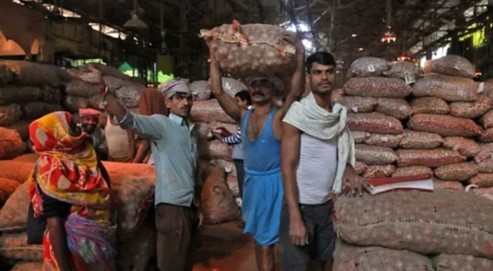
Reasons for inflation surge in recent times:
- Prices of crude oil and other commodities rising due to disruptions in global supply chains in the wake of the Russia-Ukraine war is the primary reason for the current inflation growth.
- Market inefficiencies at producer level induced due to Covid pandemic has been seen.
- There is an increased number of non-performing assets (NPAs) for MSME in FMCG sector.
- The pricing power has shifted substantially to larger enterprises causing a cost push inflation.
- In industrial sector like automotive industries, a shortage of MSME suppliers handed the ability of commanding higher prices to the remaining component makers.
- The after-effects of the pandemic-induced lockdowns and the current spike in COVID-19 cases in China's Shanghai could also have affected the present price rise.
How will it affect the economy?
- A worrying prospect is that of the CPI-based annual inflation converging towards the WPI-based inflation, in deviation from the usual trend of the wholesale price inflation collapsing in the direction of the retail price rise.
- This indicates a probable future CPI inflation rise.
- Wholesale prices are more volatile as they are driven by global factors. However, wholesalers do not always pass the burden to retailers.
- This is due to the contracts in place and also the expectation that price rise is temporary. This way, they would not be hurting the customer, and therefore the demand.
- However, if the WPI soars for a prolonged period of time, manufacturers and wholesalers will eventually pass it on to consumers.
- Although the Monetary Policy Committee (MPC) of RBI focuses on CPI based inflation and government mandate requires RBI to keep inflation at 4%, with a 2-percentage point leeway on either side, a rising WPI inflation will not be good news for the policymakers in MPC in the future.
Sources:
Siachen Day
On 13 April 1984, Operation Meghdoot' was launched. In an unimaginable feat of grit and bravery, the Indian army gained control over the dominating heights on the main passes of the Saltoro ridge, Sia La and Bilafond La. Indian Army marks Siachen Day on April 13 every year. The day is observed to commemorate the courage of the Indian Army under "Operation Meghdoot". In 2003, Late Dr APJ Abdul Kalam became the first President and Supreme Commander of the Armed Forces to visit the troops deployed in 'Operation Meghdoot.' The Siachen Glacier is the highest battleground on earth, where India and Pakistan have fought intermittently since 1984. Both countries maintain a permanent military presence in the region at a height of over 6,000 metres (20,000 ft). More than 2,000 soldiers people have died in this inhospitable terrain, mostly due to weather extremes and the natural hazards of mountain warfare
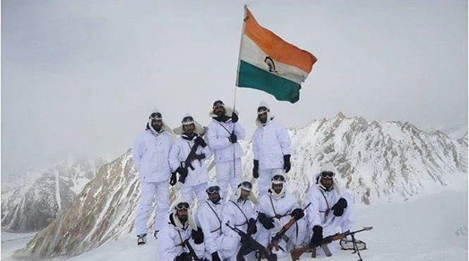
Source:
Poverty and Hunger in India, and PMGKY – IMF Report
In News
India has almost eradicated extreme poverty and brought down consumption inequality to its lowest levels in 40 years through state-provided food handouts, according to a new working paper published by the International Monetary Fund (IMF).
About the Report
- The report, ‘Pandemic, Poverty and Inequality: Evidence from India’ examines the magnitude of India’s contribution, if any, to the world increase in extreme poverty.
- For the first time in several decades, extreme poverty (those falling below the $1.9 PPP 2011 dollars per person per day) in the world increased in the pandemic year 2020.
- The traditional detailed household survey has not been possible in the last two years.
- Moreover, unlike other studies, this report has incorporated estimation of poverty including in-kind subsidies, analysis of the effect of tax credits.
Key Findings of the Report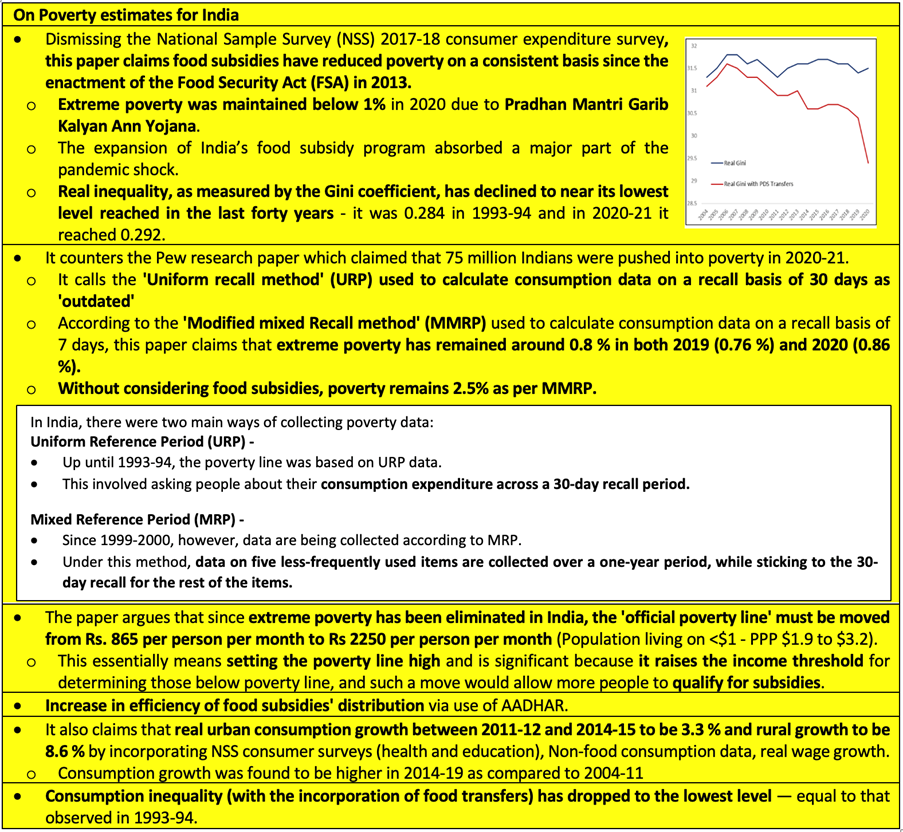

Pradhan Mantri Garib Kalyan Yojana (PMGKY)
- In 2016, the government launched PMGKY to ensure tax evaders declare unaccounted money and avoid penalty and criminal prosecution.
- In 2020, it was extended to include relief packages during the pandemic.
- The aim was to support livelihood of poor during COVID-related lockdowns.
- A relief package worth Rs. 1.70 lakh crore was announced by the Union Finance & Corporate Affairs Minister Ms. Nirmala Sitharaman under the PMGKY.
- Pradhan Mantri Garib Kalyan Package was extended till October 2021.
PM Garib Kalyan Ann (अन्न) Yojana (PM-GKAY)
- It is a component under PMGKY.
- The scheme has been under implementation since April 2020 as the largest food security programme in the world.
- It has been extended till September 2022.
- 80 crore individuals, i.e, roughly two-thirds of India’s population are covered under this scheme.
- Beneficiaries: Farmers, Women Jan Dhan Account Holders, MGNREGA Workers, Women SHGs, Old Age / Widow / Disabled pensioners, Private employees, Migrant workers, NFSA beneficiaries of both categories – Antyodaya Anna Yojana (AAY) and Priority Householders (PHH).
- This allocation was in addition to normal allocation done under the National Food and Security Act, 2013, to ensure that people can access food at affordable prices.
- In the new form, there is no requirement of ration card or ID to avail food items under this PMGKAY scheme.
- The government has been giving 5kg rice/wheat to bulk consumers under the Open Market Sale Scheme policy to improve availability in the domestic market and check prices.
- The procurement is done through nearest public distribution centres or fair price shops.
- To ensure adequate availability of protein to all the above-mentioned individuals, 1 kg per family, would be provided pulses according to regional preferences.

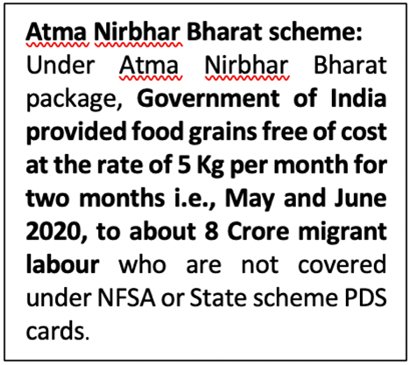
Problems with PM-GKAY:
- There has been a cause of delay during the lockdown due to availability, procurement and transportation issues for distribution of ration under PM-GKAY
- The processing of pulses needs to be done at the mills, which were working at half their capacity during the lockdown. There are other logistical difficulties faced by the mills on account of the lockdown, primarily shortage of labour and packaging material.
- The beneficiary list for the scheme is dependent on the last census in 2011. But the number of food-insecure people has increased since then and they remain uncovered.
- The beneficiary list cannot be expanded unless we hold the next census.
Other Components of Pradhan Mantri Garib Kalyan Package
Conclusion – A hungry India with reduced poverty:
- The 2021 Global Hunger Index (GHI) released in 2021 indicated that the world will not be able to meet the goal of zero hunger by 2030.
- The findings of the report are of concern for India in particular, which was placed 101st among the 116 countries assessed, even with an improvement in total score.
- India is among the 47 countries most likely to not reach the zero-hunger goal, according to the report
- Even with extreme poverty eradicated, India needs to amp up its efforts to achieve SDG 2 of Zero Hunger.
- Furthermore, Poverty estimation techniques need to be revisited and household surveys need to be done periodically to get a better approximation of the state of poverty in India.
- India needs to take efforts to make sure the families that have risen above poverty line do not relapse into poverty during times of shock, as was seen during the pandemic.
- India’s Poverty Alleviation strategy is two fold - provide greater opportunity for the poor to participate in the growth process by focusing on specific sectors and, poverty alleviation and social sector programme focused on weaker sections of society.
Question: Discuss the OM gareeb Kalyan yojna in context of recent trends in poverty reduction in India.
Sources:
- IMF report lauds 'Anna Yojna' for averting extreme poverty during pandemic
- Pandemic, Poverty, and Inequality: Evidence from India
- India eradicates ‘extreme poverty’ via PMGKY: IMF paper
- Poverty was at its lowest in India in 2020: IMF report
- Modi govt promised free pulses to 20 crore, only 18% have got them so far
- India is reeling under hunger. Will government intervention during COVID-19 help?
- Cabinet approves extension of Pradhan Mantri Garib Kalyan Anna Yojana (PM-GKAY) foCabinet approves extension of Pradhan Mantri Garib Kalyan Anna Yojana (PM-GKAY) for another 6 months (April-September, 2022)r another 6 months (April-September, 2022)
- Atma Nirbhar Bharat scheme to provide free food grains to migrant labour kicks off
- SDG 1: No Poverty
- Ex-Gratia Payments to Women Under PMGKY: RTI Shows Major Discrepancies in Implementation Data
- PRADHAN MANTRI GARIB KALYAN PACKAGE
- Finance Minister announces Rs 1.70 Lakh Crore relief package under Pradhan Mantri Garib Kalyan Yojana for the poor to help them fight the battle against Corona Virus
- The Pradhan Mantri Garib Kalyan Yojana / Package
- Under ‘Pradhan Mantri Garib Kalyan Package (PMGKP): Insurance Scheme for Health Workers Fighting COVID-19’, a New system of processing of the Insurance claims introduced to streamline the Process
- Pradhan Mantri Garib Kalyan Package - Progress so Far
- Pradhan Mantri Garib Kalyan Anna Yojana 2022 (PM-GKAY) – 5 Kg Free Food Grains to Poor People PDF
- PM Anna Yojana reaches targets, but not fully, studies show
DNA nanotechnology
This is image of use of DNA nanotechnology, wherein multiple ingredients can be mixed within these nano-containers. Scientists in Denmark have created a new technique that could speed up the development of vaccines and other pharmaceutical products by more than one million times while minimizing costs. The new method works by using soap-like bubbles as nano-containers. In search of pharmaceutical agents such as new vaccines, the industry routinely scans thousands of related candidate molecules. But this novel technique allows that process to take place on the nanoscale, minimizing the use of materials and energy. Essentially, more than 40,000 different molecules can be synthesized and analyzed within an area smaller than a pinhead and results can be produced in a matter of minutes. The solution is named “single particle combinatorial lipidic nanocontainer fusion based on DNA mediated fusion” – or SPARCLD. The process involves integrating elements from distant disciplines: synthetic biochemistry, nanotechnology, DNA synthesis, combinational chemistry, and even machine learning.
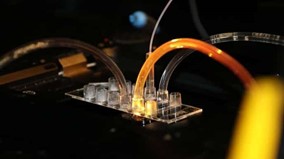
Source:
Vertical Engagement and Partnership Program (VEPP)
- Context: The Department of Telecommunications (DoT) has invited Expression of Interest (EoI) for “5G Vertical Engagement and Partnership Program (VEPP)”initiative recently.
- It is an initiative that seeks to build strong collaboration partnershipsacross 5G Use-case ecosystem stakeholders with velocity and with an exclusive emphasis to address User/Vertical Industry needs.
- Under this initiative, the DoT will “facilitate necessary approvals, regulatory clearancesto enable use case prototyping, pilots, demos, trials at the user or vertical industry premises”.
- DoT will facilitate access to experimental spectrum, access to testbeds and engagement with academia, other ministries for necessary regulatory policies and pilots wherever feasible.
- The technology stakeholders, which agree to be a part of the partnership will work to develop and deploy prototypes and pilots for 5G use cases as per the needs of the respective ministries or industry verticals to help accelerate commercial usage and adoption by enterprises.
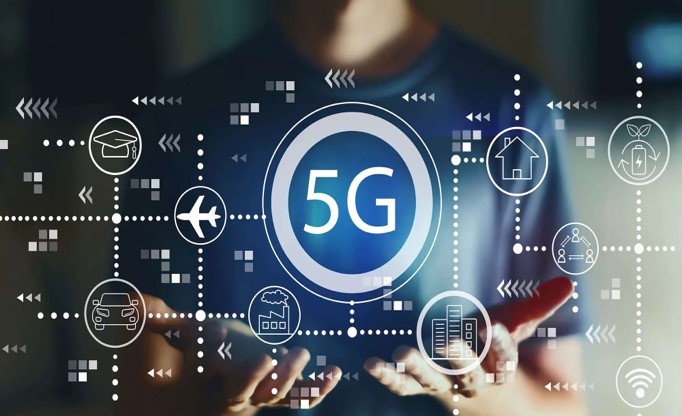
Sources:
- Department of Telecommunications invites Expression of Interest for 5G Vertical Engagement and Partnership Program (VEPP) initiative
- DoT invites ministries, industry tie-up to build 5G use-case ecosystems
Image Source:
SFDR-based propulsion
- Context: India has successfully flight tested Solid Fuel Ducted Ramjet (SFDR) booster, at the Integrated Test Range (ITR) in Chandipur recently.
- The SFDR-based propulsion system enables the missile to intercept aerial threats at very long range at supersonic speeds.
- The major difference between this missile and the regularair-to-air missiles is the air-breathing ramjet propulsion technology, which helps propel the missile at high supersonic speeds (above Mach 2) for engaging long range targets.
- It has been developed by Defence Research and Development Laboratory, Hyderabad, in collaboration with other DRDO laboratories such as Research Centre Imarat, Hyderabad and High Energy Materials Research Laboratory, Pune
- Ramjet is a form ofair-breathing jet engine that uses the engine’s forward motion to compress incoming air without an axial compressor or a centrifugal compressor.
- This is an important milestone towards development of critical missile technologies in the country.
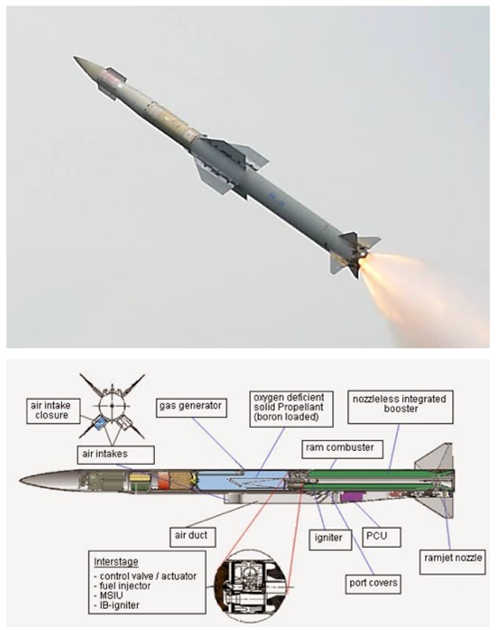
Sources:
- India successfully flight testes missile system SFDR booster
- India successfully flight testes missile system SFDR booster
Image Source:
ID cards to Myanmar Refugees
- Context: The Mizoram government has been issuing identity cards to about 30,000 Myanmarese refugees who have taken shelter in the state.
- These refugees are those who have fled the military coup in Myanmar in 2021.
- The majority of them are Chins, also known as Zos, who share the same ancestry, ethnicity and culture with Mizos of Mizoram.
- These are temporary identity cards that include their name, father’s name, age, place of origin and their current residence.
- This certificate is titled “Temporary Certificate of Identity of Myanmar Nationals”, and states that the bearer is a Myanmar national residing in Mizoram and the purpose of the certificate is only for identification.
- The IDs have been issued for the safety of the refugees as well as their easier identification.
- The process was facilitated by the District-Level Refugee Committee, under the district administration.

Sources:
- Mizoram government issues identity cards to Myanmar refugees
- Mizoram issues IDs for Myanmar refugees
Image Source:
AVSAR Scheme
- Context: AAI Airports have recently provided platform to SHGs through ‘AVSAR’ Scheme.
- The AVSAR” (Airport as Venue for Skilled Artisans Of The Region) scheme has been launched to encourage the talent of women, artisans and craftsmen.
- Under “AVSAR” an opportunity to help the indigent to mobilize their households into functionally effective self-earned groups for self-reliance and self-dependence, has been provided.
- Added to this, an area of 100-200 square feet has been earmarked at each AAI operated airport.
- The space is allotted to the SHGs, turn on turn basis, for a duration of 15 days.
- Few outlets have already been commissioned at Chennai, Agartala, Dehradun, Kushinagar, Udaipur & Amritsar Airport wherein SHGs operated by local women, are showcasing and marketing their homemade local products like Puffed Rice, Pickles, Bamboo based Ladies products, local artefacts, traditional craft, indigenous weaves with contemporary design to the air travellers.
- Self-help Groups are India’s most powerful channels for empowering small and rural communities to move from subsistence to sustainability.
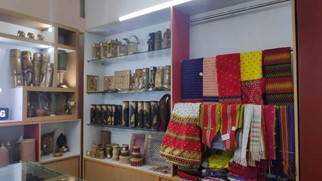
Sources:
- AAI airports provide platform to local artisans for promotion through AVSAR Scheme
- AAI Airports providing platform to Self-Help Groups for promotion of local artisans and products through ‘AVSAR’ Scheme
Image Source:
Why is family planning so women-centric?: The Hindu Businessline
Essence: The findings of the NFHS-5 substantiate the well-known fact that at 37.9% female sterilisation is the primary mode of contraception in India with 75% of them occurring in public institutions, and 33% are done post-partum. The reasons for such high female sterilisation are due to stigma, perception of sterilisation as emasculation, misinformation concerning the side-effects, cultural and religious beliefs, lack of decision-making power with women and attitudes of service providers.
Lack of awareness of alternative methods and unmet need for modern contraception is leading to poor reproductive outcomes and unwanted pregnancies. Women are often not told about the side effects or misinformed or even coerced into sterilisation. Absence of a pool of choices such as laparoscopic tubectomy in remote and rural areas or enough surgeons, poor quality of care combined with time-bound and targeted mass sterilisations in camps is a violation of women`s choice and dignity.
Why should you read this article?
- To know about the NFHS-5 findings on the family planning methods used in India.
- To know the reasons behind the gap between female and male sterilisations.
- To know the consequences of lack of access to modern contraception methods and the problems women face while undergoing surgical procedures.
Source:
A merger to better manage the Indian Railways: The Hindu
- Essence: The editorial talks about the need for merger of various services of Indian Railways into one Indian Railways Management Services (IRMS). Railways is a demanding job, requiring round the clock work on operations, maintenance, development, exigency handling, developmental planning and execution. Such demand needs the railway cadre to be lean, efficient and flexible. IRMS would support to offer such requirements.
The integrated government online training- initial and mid-career (iGOT) under Mission Karmayogi will help to create a competitive and rewarding career for the efficient work force. It will help in domain, function, and behavior competency mapping of the staff. Railway has a daunting task to implement Gati Shakti master plan, steer the growth for dedicated rail freight corridor, introduce high speed passenger railways, modernize and re-develop rail infrastructure. IRMS will be an important step in the same direction.
Why should you read this article?
- To understand the need for merger of various railway services into one cadre.
- To know the future plans for Indian railway development.
Source:
HOPS as a route to universal health care: The Hindu
Essence: The editorial speaks for provision of health as an optional public service (HOPS) in India and rallies behind the idea that no one should be deprived of quality health care for the lack of ability to pay. Universal health coverage could be delivered to people through two means- providing public service or social insurance. Public services like primary and preventive treatment need to be revamped in India. The social insurance scheme relies on public and private insurance (non-profit motive) and is financed by general corpus like taxation.
Certain inputs like having primary care facilities is important to deliver any medical service, devoid of which the individual might urgently expend out-of-pocket finances. It is equally important to regulate private health care and social insurance, devoid of which they’d run behind profit motive and extract finances from public pool/individual expenditure.
Thus, HOPS could be provided to people with certain basic facilities available to all persons and social insurance covering certain procedures (high end surgery). Specifying norms, scope and quality standards would be the way forward. Right to Health bill in Tamil Nadu is a right step in the same direction.
Why should you read this article?
- To understand the need for health as a service to the masses.
- To know the loopholes in social and health insurance schemes.
Source:
Helipad Hockey
Background
Overcoming odds, nine tribal young girls from the Indo-Tibetan Border Police (ITBP) Hockey Academy have come to the lofty Hockey India Sub-Junior and Junior National Trial Camp, Chhattisgarh.
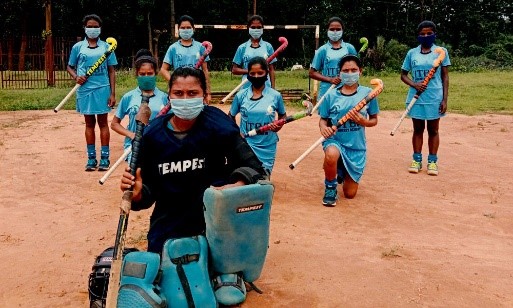
About the Helipad Training Ground
- The ITBP organized the training of these girls on the local helipad, which is the only accessible open space in the extremist region.
- The selected girls were provided with basic gear and equipment. In 2016, these girls were not even aware of how to hold a hockey stick or how to play while wearing sports shoes.
- These girls have access to minimum resources but the best possible training under the ITBP Head Constable Surya Smit.
- The young girls, studying at the nearby school Mardapal Kanya Ashram, have become an identity of women empowerment in the Bastar region.
Quote: “We have to fight the entire time, we can’t start at the end when it’s getting down to crunch time. We can’t leave anything on the floor.” – Kerri Walsh, Volleyball Player
Source:
Share the article
Get Latest Updates on Offers, Event dates, and free Mentorship sessions.

Get in touch with our Expert Academic Counsellors 👋
FAQs
UPSC Daily Current Affairs focuses on learning current events on a daily basis. An aspirant needs to study regular and updated information about current events, news, and relevant topics that are important for UPSC aspirants. It covers national and international affairs, government policies, socio-economic issues, science and technology advancements, and more.
UPSC Daily Current Affairs provides aspirants with a concise and comprehensive overview of the latest happenings and developments across various fields. It helps aspirants stay updated with current affairs and provides them with valuable insights and analysis, which are essential for answering questions in the UPSC examinations. It enhances their knowledge, analytical skills, and ability to connect current affairs with the UPSC syllabus.
UPSC Daily Current Affairs covers a wide range of topics, including politics, economics, science and technology, environment, social issues, governance, international relations, and more. It offers news summaries, in-depth analyses, editorials, opinion pieces, and relevant study materials. It also provides practice questions and quizzes to help aspirants test their understanding of current affairs.
Edukemy's UPSC Daily Current Affairs can be accessed through:
- UPSC Daily Current Affairs can be accessed through Current Affairs tab at the top of the Main Page of Edukemy.
- Edukemy Mobile app: The Daily Current Affairs can also be access through Edukemy Mobile App.
- Social media: Follow Edukemy’s official social media accounts or pages that provide UPSC Daily Current Affairs updates, including Facebook, Twitter, or Telegram channels.


